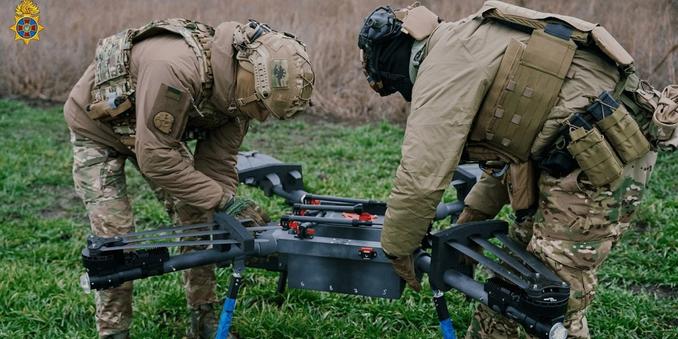Hidden Electronic Warfare Battle Demanding More of Ukrainian Soldiers https://www.byteseu.com/?p=727443 #AlternativeSystem #bi #drone #DroneOperator #enemy #EW #Frequency #HiddenElectronicWarfareBattle #jamming #Russia #signal #SpecialDroneUnit #typhoon #Ukraine #unit
Viimatised otsingud
Otsimisvalikud
#unit
https://www.europesays.com/1831257/ Hidden Electronic Warfare Battle Demanding More of Ukrainian Soldiers #AlternativeSystem #america #bi #business #drone #DroneOperator #enemy #EW #Frequency #HiddenElectronicWarfareBattle #jamming #Russia #signal #SpecialDroneUnit #typhoon #Ukraine #unit #UnitedStates #UnitedStatesOfAmerica #US #USA
Ukrainian Commander Shares New Details of Shock Invasion Into Russia https://www.byteseu.com/711460/ #1stPlatoon #BusinessInsider #DaringInvasion #Kursk #Mission #OleksiiVovkotrub #OwnTerritory #part #Russia #ShockInvasion #Ukraine #UkrainianCommander #UkrainianForce #unit #village
GoFundWar: How Ukraine Is Crowdfunding Its Battle Against Russia https://www.byteseu.com/538167/ #AdvancedMilitary #crowdfunding #DianaKulyk #DimkoZhluktenko #donation #equipment #father #FUND #ReconnaissanceDrone #ruslan #Russia #Soldier #Ukraine #unit #War
https://www.europesays.com/1640551/ Russian Deserter Says Constant Lie-Detector Tests on Nuclear Base #anton #BbcNews #ConstantLieDetectorTest #CriminalCase #DayRussia #Invasion #LastWeek #MediaOutlet #nuclear #NuclearBase #NuclearWeaponBase #OfficialDocument #Russia #RussianDeserter #Ukraine #unit
Cold-Case Ermittler in Dortmund: Neue Hinweise auf alte Mordfälle
Helping a friend at a #storage #unit the other day, I had a revelation: indoor storage units are dungeons, in the #DnD sense. Long straight #corridors, all at right angles, neat units of distance, and #niches full of #treasure to either side.
Which makes me think it would be a lot of fun to run a game in a far-post-apocalyptic-#fantasy setting, preferably without the players knowing at first that’s what it is, where they are exploring a #dungeon which turns out to be a buried building. The niches all have cryptic symbols above them they can’t decipher, but which appear to be some kind of numbering system. When they pick or break the ancient locks, they find some niches have ancient treasures, while others contain incomprehensible #artifacts, and still others are full of plain junk.
The main danger on the upper levels comes not from #monsters, but from precariously piled heaps that fall down as the doors are opened. The players, of course, will perceive these as #traps.
A dungeon needs some monsters. Here they’re more numerous on the lower levels, in the form of #undead employees. The players will eventually discover that they venture forth from a chamber on the bottom level, known in the ancient tales as the “Manager’s Office.” The #Manager itself is the final boss fight.
Upon defeating the Manager and venturing out the door, they find that the lower levels of the building are surrounded by a vast #cavern, with an oddly flat floor and the ruins of a huge sign. The party sage puzzles out the ancient writing: PUBLIC STORAGE.
… I guess outdoor units are ruins, but anyone DMing that game needs to figure out how they’ve lasted that long. A #curse is a chillingly believable explanation.
[En] [FR in the thread]
We need a new #unit !
Have you ever felt that motorway signs using a number of km to represent the distance to a destination is somehow pointless ? I mean, what matters for a driver is the remaining travel time. And if a city is 100km away and your car speedometer shows that you drive at 130km/h, you shall compute mentally 100/130*60 to get the number of minutes remaining...
Let's create a new unit for our speedometers that can be more usable. I propose that instead of showing speed (km/h), we use the inverse of speed (h/km). Yet, the number of hours to travel 1km doesn't feel nice. So let's try to scale this unit so that we get something that is more significant for a driver.
I propose that this new unit shall represent the number of minutes to travel 10km. (see attached figure).
I will call this unit "Road Unit", but I don't think it's a practical name so we will need to figure out another one I think.
So here we have something that I think is significant enough ! Look, for instance, if I am on the motorway, 100km away from my destination, and I know my speed in Road Units is 5.45 R.U. (110km/h), I can easily compute that if 10km is 5.45min, then 100km is 54.5 minute (55min30s). And there we go.
Other advantage: I drive in the country side. I would normally drive at 7.5 Road Units (80km/h). But today I am stuck behind a truck at 8.6 R.U. (70km/h). I can mentally estimate that I will lose 7.5-8.6 = 0.9min every 10km. Since I know my destination is 20km away, I will lose a bit less than 2 minutes. So no need to put me in danger by trying to overtake it.
If this idea was convicing enough, please, boost, share, talk about it inside and outside of fediverse. Maybe one day we will have GPS and speedometers that will implement this unit natively! o/
Feel free to react and bring up suggestions, and feel free to propose another name: I don't think that "I drive at 5.5 road units" is... ergonomic... I don't know...
Unit X:
New Book Co-authored by Former F-16 Pilot Raj M. Shah Offers Inside Look at
Pentagon’s Defense Innovation
A new book by technology entrepreneur Raj M. Shah and Christopher Kirchhoff offers an inside look at the #Defense #Innovation #Unit,
also known as "Unit X"
an elite unit within the Pentagon, which they co-founded in 2016.
“Unit X: How the Pentagon and Silicon Valley Are Transforming the Future of War,”
takes the reader “inside AI labs, drone workshops, and battle command centers, and, also, overseas to Ukraine’s frontlines,” according to the book’s synopsis by its publisher Simon & Schuster.
Unit X was established to bring Silicon Valley’s cutting-edge technology to America’s military.
It was specifically designed as a bridge to Valley technologists that would accelerate bringing state-of-the-art software and hardware to the battle space.
Before Unit X was established, the Pentagon was known for its uncomfortable relationship with Silicon Valley and for slow-moving processes that acted as a brake on innovation.
Shah, Kirchhoff, and others in the Unit who came after were tasked particularly with meeting immediate military needs with technology from Valley startups.
“Unit X” opens with an anecdote when Shah first experienced the way Silicon Valley impacts the workings of U.S. defense companies, the Financial Times noted.
At the time Shah was a 27-year-old U.S. Air Force captain, who was on a pre-dawn patrol in 2006.
He was “flying an F-16 fighter jet near Iraq’s border with Iran when he realized that he did not know which side of the border he was on,” the Financial Times said.
That was “a serious problem,” the publication stated,
adding that
“entering Iranian airspace could cause an international incident.”
Shah could also have been shot down, the report added.
So, Shah “figured out a simple hack”...
“He loaded a handheld device that he used for emails with civilian navigation software,” the report said.
“The next time he flew a mission, Shah strapped the device to his leg.
Remarkably, the $300 gadget did a better job of telling him where he was than the navigation systems of the $30 million jet.”
The book underscores the importance of strengthening the relationship between Washington and Silicon Valley
“In an era when America’s chief rival, China, has ordered that all commercial firms within its borders make their research and technology available for military exploitation,
strengthening the relationship between Washington and Silicon Valley is an urgent necessity.”
The Financial Time notes that the book also “stresses the need for the U.S
— and by extension, the west
— to maintain technological parity with its adversaries, and so deter war
#Washington #StatePrisons #Suppress #CulturalAwareness #Groups
After nearly a month in #solitaryconfinement, I’m being #transferred to yet another #solitary #unit at a #prison two hours away, #shackled, #cuffed, and my #future uncertain. My #organizing #work with #CulturalAwarenessGroups (#CAGs) has #struckanerve with the right (or wrong) people.
#Women #Transgender #LGBTQ #LGBTQIA #Washington #Police #Incarceration #Hate #Bigotry #Violence #NoPoliceAtPride
https://solitarywatch.org/2024/08/05/washington-state-prisons-suppress-cultural-awareness-groups/
#Transgender #Thai #beautyqueens #shock #army by turning up for #military #draft, striking good looks stun #socialmedia
In #Thailand, #transgender #people can #apply for #exemption from #militaryservice if they can provide relevant #medical #certificates, but they still need to report to the #conscription #unit.
#Women #Transgender #LGBTQ #LGBTQIA #Thailand #MilitaryService #Representation #Culture





